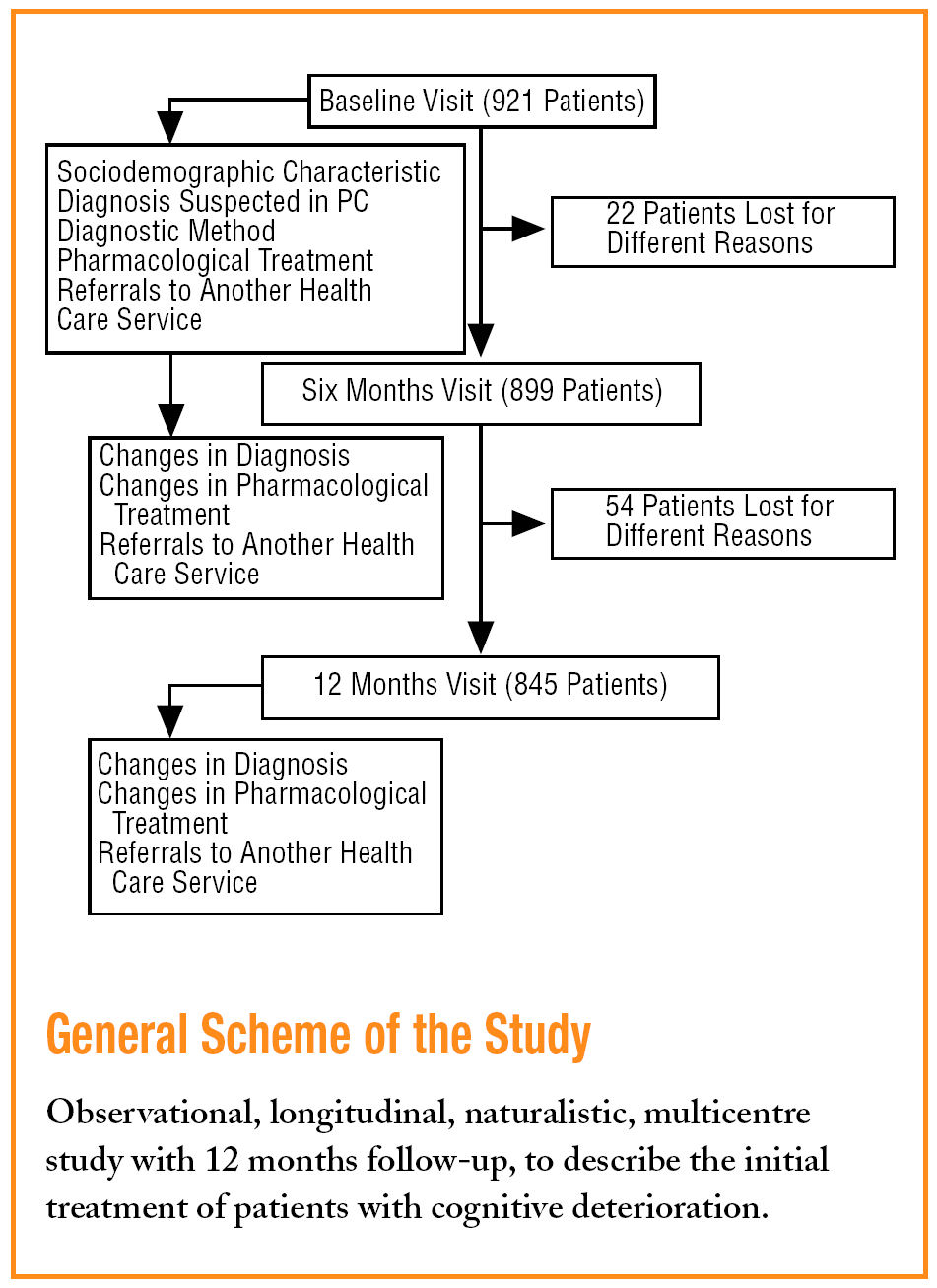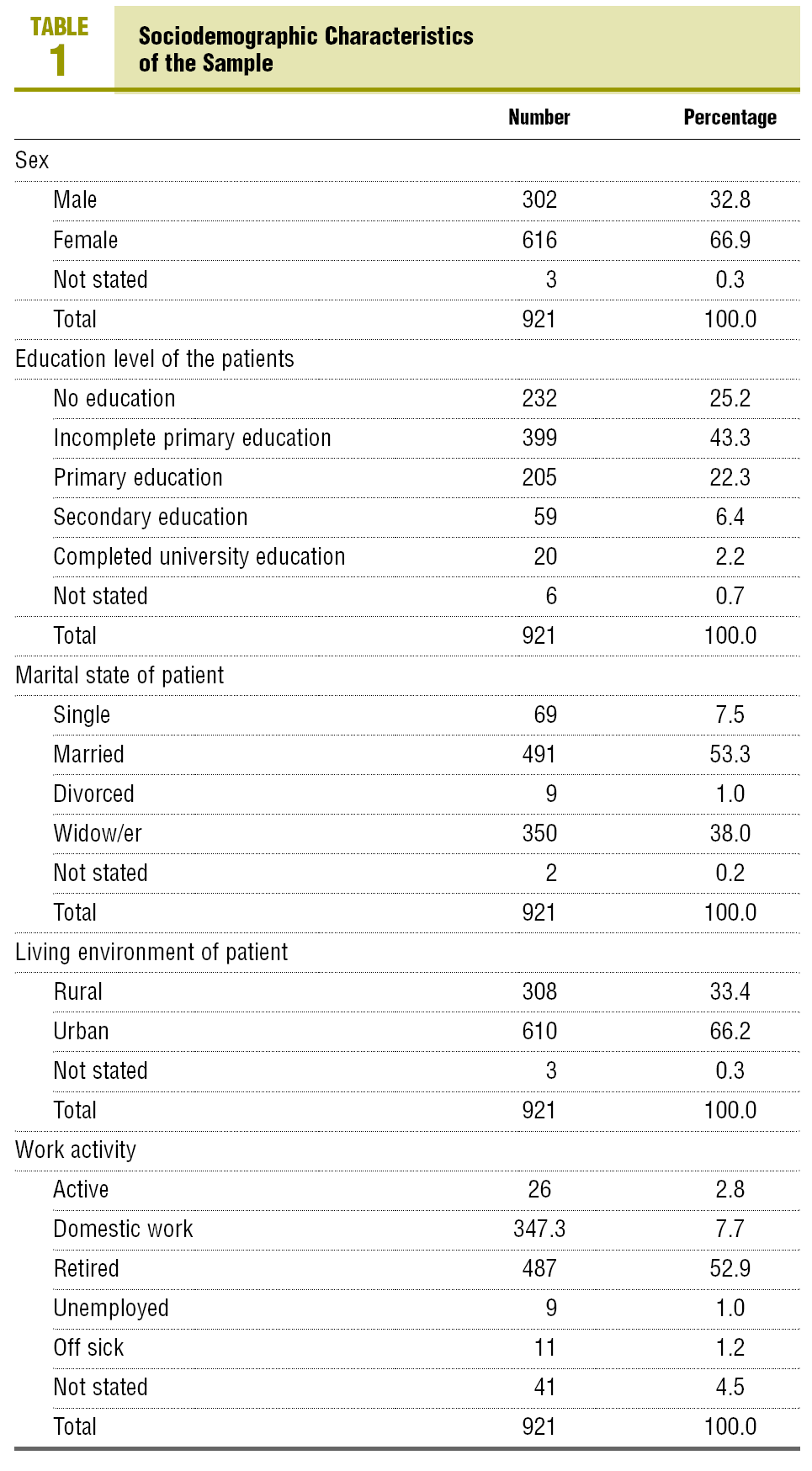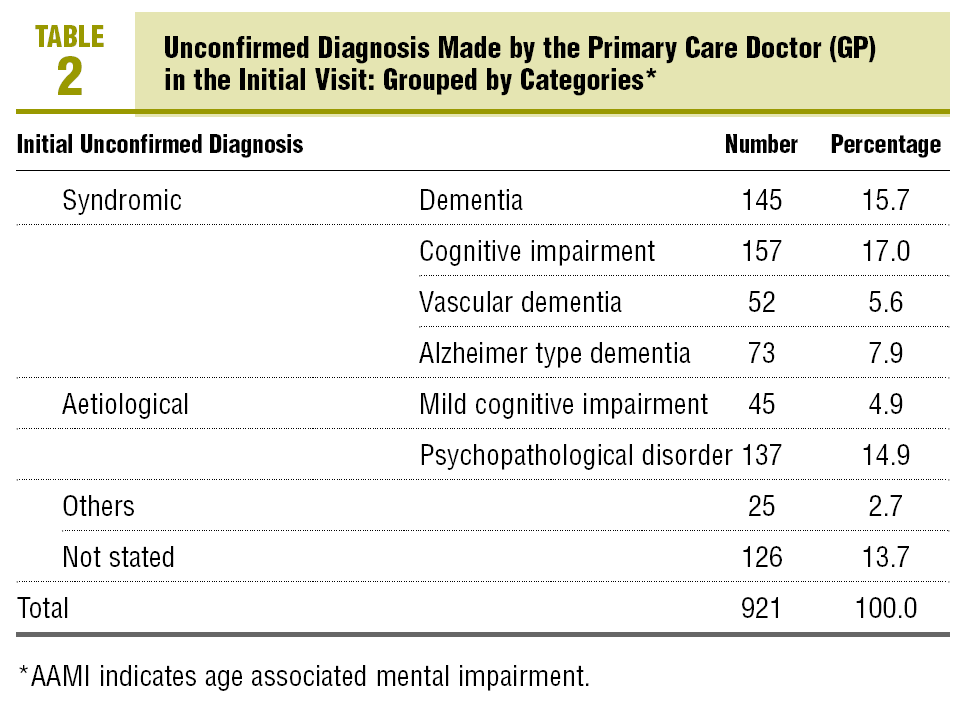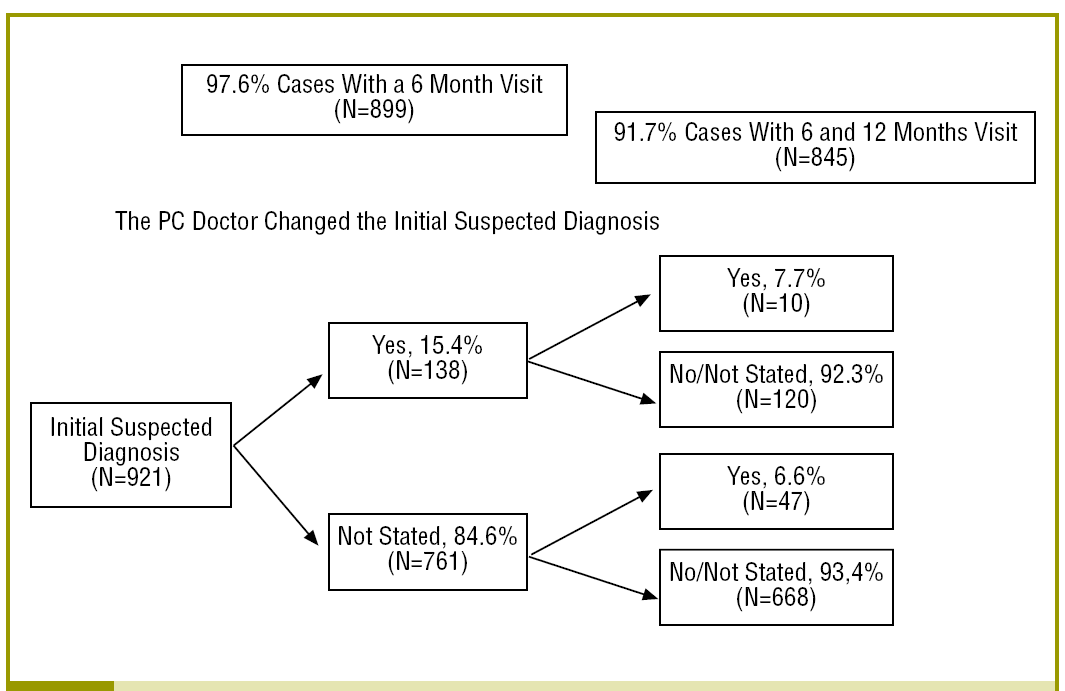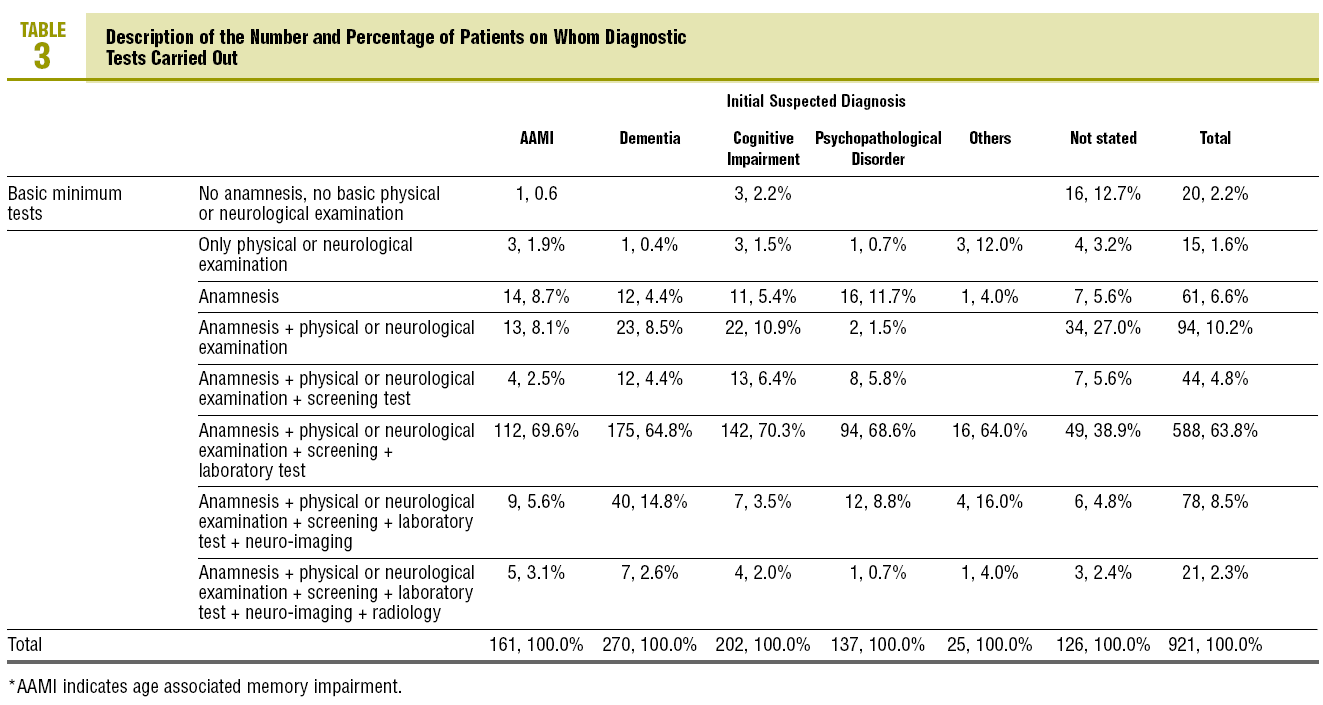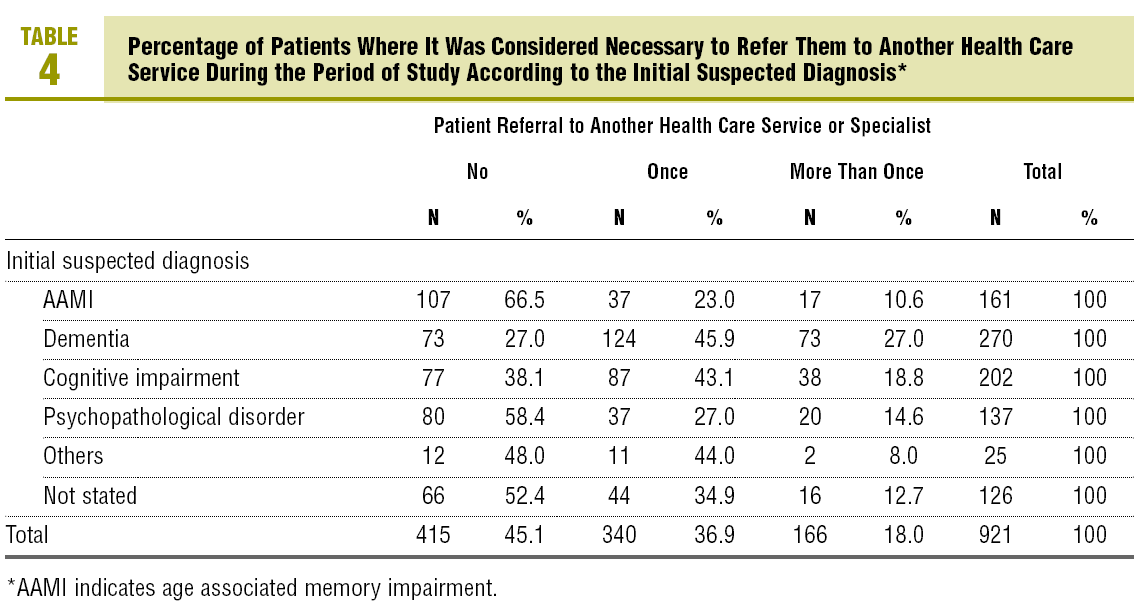Introduction
Family doctors or general practioners (GP) are normally the first (and on many occasions the only) contact that patients with subjective memory complaints and/or cognitive impairment have with the health service. It is obvious that the GP is in an excellent position to detect cognitive impairment in their patients due to the continuity of health care, the accessibility of the population and the their function as gatekeeper or doorman at the entrance to the health service. In fact, in our country, almost every elderly person has been in contact with their GP in the last 12 months.1
The National Care Plan for Alzheimer patients and other dementias confirms these suppositions by stating that primary care (PC) must be the centre and fundamental axis for the care and coordination of the patient with dementia.2
Until recently, the most important problem for GPs, as regards the diagnosis and treatment of dementia consisted of ruling out delirium and other potentially treatable cause. However, as better therapeutic options are available, it is essential that dementia is diagnosed as soon as possible.3
Besides being able to start pharmacological treatments that act by maintaining cognitive function and delaying the symptoms,4 early diagnosis enables the patients and their families to adapt to the new situation, improving their overall quality of life.5
Different studies have reported certain GP attitudes that could be an obstacle to achieving this objective: nihilism towards the available therapeutic options, fear of stigmatising the patient, lack of training, or not convinced of the benefits of an early diagnosis.6-9 There is little information on how to approach these patients in PC in Spain.
Different epidemiological studies on dementia have been published in Europe and Spain10 and they agree that the prevalence of dementia and Alzheimer disease (AD) increase with age, and it doubles at 5 year intervals.11,12 In a recent study, the prevalence of dementia was found to be around 5.4% in patients ≤60 years old and 24.8% in patients ≤85 years old.12 This study estimated that the annual incidence rate of dementia was 8.8 new diagnoses per 1000 subjects. On the other hand, it is known that the incidence of AD also increases with age up to 85 years and from that age it only increases in women.13
The objective of this study is to report on the treatment of patients <60 years old, with no previous aetiological diagnosis, with subjective memory complaints and/or cognitive impairment, within the PC setting, under normal clinical practice conditions and with a follow-up period of 12 months.
Methods
An observational, longitudinal, multyicentre, and naturalistic study on the treatment of memory complaints and/ or cognitive impairment of patients >60 years attending PC clinics in Spain. The participants came from 105 rural and urban PC centres from all over the country.
Patients <60 years who were being attended to by their GP for at least 6 months with subjective memory complaints and/or cognitive impairment as the main reason for the visit, that were already mentioned by the patients themselves or their partner, and provided a previous aetological diagnosis was not made, were consecutively included over a 9 month period from September 2001 to May 2002. Cognitive impairment is defined as a change in the previously conserved intellectual faculties, particularly including, orientation, recent memory, reasoning, arithmetic, language, the ability to carry out complex tasks, and the organising ability.14
Gathering of Information
All patients made 3 scheduled visits (baseline, at 6 months, and at 12 months). In the first visit, information was collected on the patient sociodemographics, the diagnosis suspected by the GP, the diagnostic method, pharmacological treatments prescribed for cognitive impairment, and referrals to another health care service (type of specialist and reason). In the follow-up visits, information regarding change in diagnosis and/or treatment by the PC doctor and transferrals to other health care service (type of specialist).
The basic minimum tests, anamnesis, physical, and/or neurological examination, were used to perform the diagnosis. A scale within the rest of the diagnostic methods was established from these 2 tests, in such a way that every rung higher led to a more complete study of the patient. The scale progressively included the following tests: screening test, laboratory tests and neuro-imaging tests (computed tomography [CT] and magnetic resonance [MR]), and radiology.
Given the dispersion of the diagnoses, these were coded and grouped by a medical practioner into 7 syndromic or aetiological diagnostic categories. The grouping by syndromic diagnosis included the following diagnoses: age associated memory impairment associated (AAMI),15 unspecified dementia,16 and unspecified cognitive impairment.14 The aetological diagnosis group included: vascular dementia,17 Alzheimer dementia,18 mild cognitive impairment,19 and psychopathological disorder.20 "Other diagnoses" categories were established for those diagnoses that could not be grouped into the described categories and "not stated" for those that were not entered. These 7 categories were reduced to 4 that included the previous ones (AAMI, dementia, cognitive impairment, and psychopathological disorder), plus the "others" and "not stated" categories.
Statistical Analysis
The study sample size was calculated to be able to estimate the dichotomic variables with a value of P=.5 and a precision of 0.3 points, with a level of significance of 0.05, which meant a sample of 1068 patients was required.
Descriptive univariate analysis was performed on all the variables collected in the study. Data analysis was carried out using the SPSS 9.0 statistics package for Windows.
Results
Of the 921 patients included in the study, some information or a visit was recorded for 899 (97.6%) of them at 6 months and, for 845 (91.9%) at 12 months. Women made up 66.9% of the patients, with a mean age of 74.0±6.9 years, while the men had a mean age of 74.9±6.5 years (Table 1). In the majority of accompanied patients (59.6%), the person who decribed the subjective complaints was the companion, either exclusively or by corroborating the complaints mentioned by the patients themselves. The mean time of the progression of the symptoms among the patients in the study was 14.3±10.4 months.
In the initial visit the diagnoses made were the syndromic type in 50.5% (95% confidence interval [CI], 47.3-53.7), 33.3% (95% CI, 30.3-36.3) of the patients were classified based on an aetiological diagnosis, and 2.7% (95% CI, 1.7-3.7) a different diagnosis was made. No unconfirmed initial diagnosis was issued in 13.7% (95% CI, 11.5-15.9).
Table 2 shows the percentage diagnoses in each category.
During the first 6 months of follow up, the GP changed the unconfirmed diagnosis in 15.4% (95% CI, 13.1-17.7; N=131) of the patients. At 12 months the initial unconfirmed diagnosis was changed in 6.6% (95% CI, 4.8-8.4; N=47) of the patients who had not been changed in the previous visit and the new diagnosis recorded in the previous visit was changed in 7.7% of patients (95% CI, 3.3-12.1; N=10). The main changes were patients being diagnosed from AAMI and cognitive impairment to some type of dementia and, to a lesser extent, patients diagnosed with AAMI, dementia or cognitive impairment to some type of psychopathological disorder (Figure 1).
FIGURE 1 Description of the percentages of patients who had their initial suspected diagnosis changed by the primary doctor during the development of the study.
As regards the examinations carried out or requested, it can be seen in Table 3 that the combinationen of diagnostic test most used by the GP was a basic examination together with screening tests and laboratory tests, followed by the same group of tests plus those of neuro-imaging. The screening methods most commonly used among the patients were the MMSE/CME (67.6%), the Hamilton Depression Scale (40.65), the Pfeiffer Short Portable Mental Status (34.4%), the Yesevage test (23.3%), and the Informant test (21.5%).
Aproximately half of the patients (52.6%; 95% CI, 49.4-55.8) received treatment at the initial visit. Nootropics and neuroprotectors were prescribed in similar amounts (24%) to all groups except the psychopathological disorders where the majority was bendodiazepines and anti-depressants. Calcium antagonists were prescribed to a lesser extent (10%) to patients with dementia and cognitive impairment. At 12 months follow-up, 75.7% (95% CI, 72.9-78.5) received some type of treatment. This increase in treatment was due to the introduction of cholinesterase inhibitors in the dementia groups and a slight increase in neuroprotectors and calcium antagonists since the initial visit in these same groups.
In the first visit of the study, the GP considered it necessary to refer 363 patients (37.9%; 95% CI, 34.8-41.0). During the 12 months of the study, the GP considered it necessary to refer 54.9% (95% CI, 51.7-58.1; N=506) of patients who came to their clinic, and 18% of those had to be referred on more than one occasion. Also, during the 12 months follow-up, most of the patients who had to be referred to other health care services were sent to, neurology (77.8%), and to a lesser extent to psychiatry (22.4%) or geriatrics (9%). Dementia was the diagnostic group with most referrals (Tabla 4).
The principal reasons given for the referral to other health care services were, to complete the study, or the need to confirm the diagnosis to rule out another type of disease.
Among the neuro-imaging tests, 64.1% (95% CI, 61.0-67.2) of GPs had access to CT, and 55.3% (95% CI, 52.1-58.5) to MR. RM. As regards social health resources, 56.3% (95% CI, 53.1-59.5) of GPs had access to day centres, 91.5% (95% CI, 89.7-93.3) to a social worker, and 60.2% (95% CI, 57.0-63.4) to family associations and support groups.
Discussion
The main objective of the present study was to determine the treatment of patients with subjective memory complaints and/or cognitive deterioriation in the PC setting.
Several studies, up until now have attempted this by mainly using indirect methods using questionnaires directed at GPs, both in our country and in others. For example, we know that the National Health Service Health in England and Wales uses a test or protocol to evaluate dementia.21 Another study carried out in Finland, in which a follow-up was made of patients with dementia, demonstrated that only 34% were evaluated using a cognitive test,22 and studies carried out in our country revealed that 31%-43.5% of GPs did not use any test, and that 44% of them did not perform any complementary test for the differential diagnosis.23,24 In our study, screening tests were used on 85.9% of the patients and in a large percentage, 63.8%, they were used along with a basic examination and laboratory tests. It seems clear that the GP is capable of diagnosing around 90% of patients, whether it is in syndromic or aetiological form, by using the means available to them. Also, this diagnostic group shows very little variation with time, and these variations are consistent, with a decrease in syndromic diagnoses and an increase in aetiological ones. There are different opinions in the scientific literature as regards the use of CT and/or MR. The consensus14 appears to be that it is advisable only to perform a CT in doubtful or established cases of dementia, due to the low pretest probability25 of intracranial lesions being found in PC.23 In the present study, neuro-imaging test were only carried out on 13.6% of patients, a considerably lower percentage than that reported by Boada et al26 in their study carried out on outpatients with unconfirmed dementia attending hospital centres, where a CT was performed on 50% of patients and an MR on 13%. This difference may possibly be due to the difficulty of the GP in accessing these diagnostic services.
At the time of their inclusion in this study, more than half the patients received nootropes and neuroprotectors, drugs that have not been shown to be effective. However, cholinesterase inhibitors, which have been shown to be particularly effective in patients with mild to moderate dementia,3,4 were only prescribed to a third of all the patients at the end of the 12 months follow-up. This could be due to several reasons: the fact that these drugs can only be prescribed in specialised health care, the evolution time of the disease, since they are not indicated in advanced cases,27,28 or due to the belief by some doctors that these drugs achieve little or no results.6,8
As regards the referral rate, the percentage found was low if we take into account that the specialist is the only one who can prescribe cholinesterase inhibitors and the difficulty of the GP to gain access to these resources.
It can be concluded that the treatment of patients with subjective memory complaints and/or cognitive impairment by the GP is adequate. They can diagnose the majority of patients with the resources available, they made few changes during the 12 months follow-up and, these changes also seemed logical at the time, they use diagnostic resources well and they lack optimal accessiblity to neuro-imaging test. However, they still prescribe too many drugs that are of little use in these types of patients and few effective drugs (cholinesterase inhibitors), since they have the added limitation in that a specialist has to approve them. The referral rate obtained in this study is similar to that found in previous studies carried out in European countries.29,30 Although there are no established criteria to determine which patients should be referred, some authors state that all patients with suspicion of dementia should be referred.31,32
The design of the study itself is the most important limitation of this work, although it is also its main strength. The fact that it is an observational study
decreases and, among the possible biases, the Hartwone effect stands out, this means that the researchers knew that they were taking part in a study and they feel like they are being observed. Therfore we knew that their performance in this study differed from reality up to that point. The only way to avoid this bias is to carry out an experimental study and, given the objectives and characteristics of the study, that design could not be used, therefore it has to be considered as an inherent limitation to the study. However, as pointed out by different researchers,33,34 these types of designs are more suited to determine the reality and the space or gap between the data and daily clinical practice.
The possible deficiencies in terms of treatments detected in the present study demonstrates the need to find methods to improve this treatment and, as a result, the progression of the disease.
It would be extremely useful to carry out prospective studies directed at this progression and to obtain more information on the effectiveness of the interventions made under routine clinical practice conditions.
This study has been financed by Novartis and Esteve pharmaceutical companies.
What Is Known About the Subject
• The early diagnosis of dementia enables pharmacological measures to be taken that act on the maintenance of cognitive function and delay the symptoms, as well as allowing patients and their families to adapt to the new situation.
What This Study Contributes
• The present study has enabled us to find out the treatment used in patients with subjective memory complaints and/or cognitive impairment in the primary care setting.
• The treatment of the patients has been defined according to the treatment received by them, the carrying out diagnostic tests and referrals to specialised care.
Spanish version available at www.doyma.es/148.288
A commentary follow this article (page 177)
Correspondence: X. Badia Llach.
Avda. Diagonal, 618, 1.º C-D.
08021 Barcelona. España.
E-mail: xbadia@es.imshealth@.com
Manuscript received December 29, 2005.
Manuscript accepted for publication May 24, 2006.







